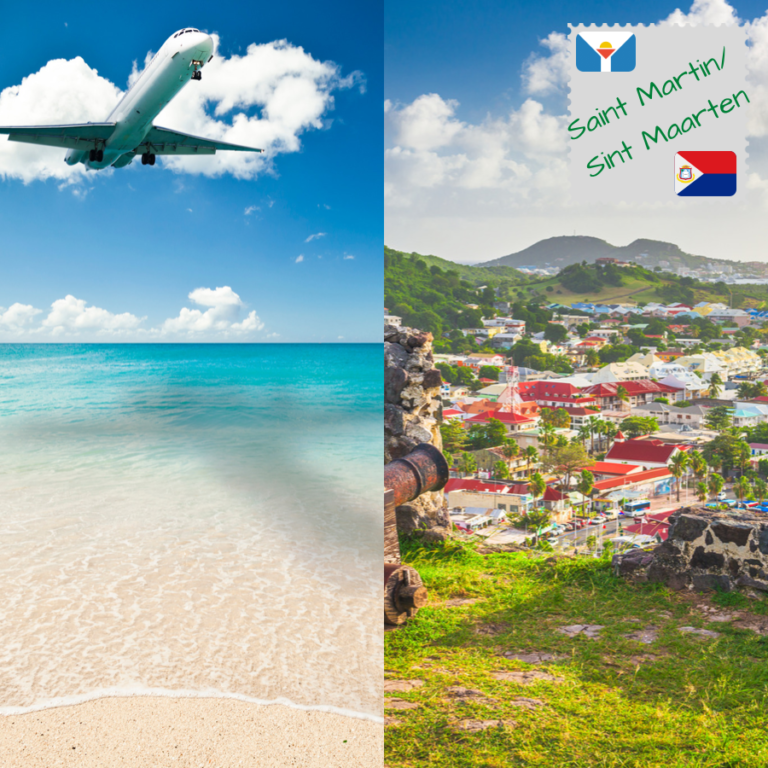
Why does this island have two different spellings? The island is in fact 2 distinct countries: Saint Martin, a department of France, and Sint Maarten, a part of the Netherlands Antilles. An obelisk and a Bienvenue/Welkom sign are the only indications of the divide. Popular legend recalls a Dutchman and a Frenchman setting out in opposite directions to walk around the island with the idea that the line drawn from their point of departure to their point of meeting would establish the boundary. It is said that the French side is larger because the Dutchman was fortified with gin and the Frenchman only with wine. In actuality, the Partition treaty of 1648 formalized the divide.


English is the day-to-day administrative language and language of communication in Sint Maarten, and the first language of the majority; however, this side of the island recognizes both languages. Local signage uses both Dutch and English. With so many nationalities present, quite a few languages are spoken. An English-based creole is the main local vernacular. However, the official languages are French for Saint-Martin. Various creole languages and dialects can also be heard around the island.

In St-Martin: euro (€). In Sint Maarten: Netherlands Antillean guilder (ANG) official, US dollar (US$) preferred and often required. The official currencies are the euro on the French side and the Netherlands Antillean guilder (called Naf) on the Dutch side, however, the latter is not in circulation and the US dollar is effectively the main currency. US dollars are also accepted in St-Martin.

Upon arrival in Sint Maarten, you must have: a U.S. passport valid for the duration of your stay. U.S. citizens are allowed to stay in Sint Maarten for a maximum of six months with the possibility to extend. U.S. citizens must have a U.S. passport with at least 6 months validity to enter the French West Indies. No visa is required for stays up to 90 days if you have an onward or return ticket, confirmation of accommodation, and can produce evidence of your ability to maintain yourself.

Because the U.S. operates on a different cell-phone standard than the rest of the world, your typical cell phone from back home won’t work in most Caribbean destinations unless your service provider offers an international plan. Buy an unlocked GSM world phone and use local SIM cards: This is your best option if you travel overseas frequently. Wifi networks are available on every corner of the island. While the internet may not always be free, many local shops may provide public hot spots.

Many (but not all) hotels and restaurants include a 15% service charge, in which case no further tipping is necessary (otherwise, add 15% to the bill). Restaurants Diners commonly leave a small amount for exceptional service. Taxis About 10% to 15%.

ATMs blanket the island but not all accept foreign cards.

You need a power plug adapter in Saint Martin when living in the United States of America. You also need a voltage converter. In Saint Martin, the power plugs and sockets are of type E. The standard voltage is 220 V and the standard frequency is 60 Hz. You don’t need a power plug adapter on Sint Maarten when living in the United States of America. On Sint Maarten, the power plugs and sockets are of type A and B. The standard voltage is 110 V and the standard frequency is 60 Hz.

The best time to visit St. Martin and St. Maarten is May and June or between November and mid-December. These select weeks are times when hotels advertise their best rates.
The best way to get around St. Martin and St. Maarten is in a rental car. But really, outside of walking, just about any means of navigating between the French and Dutch sides of the island is manageable. Having a car will allow you more mobility and you’ll find reasonable rental rates. Agencies are clustered on the outskirts of Princess Juliana International Airport (SXM), located in St. Maarten. Unfortunately, traffic can be pretty heinous on both sides. The island buses also cater to tourists and are fairly cheap to ride. If you don’t like the idea of waiting on a bus, consider splurging on a taxi. And if you’re feeling adventurous you might want to use a scooter; there’s nothing like feeling the sea breeze in your hair – ahem, helmet.
To book a taxi, call 542-2359 (Sint Maarten) or 0590-87-56-54 (St-Martin). On the Dutch side, never get in a car that doesn’t have a license plate reading ‘TXI’ indicating that it’s a registered taxi. From Juliana airport it’s US$8 to Maho, US$20 to Philipsburg, US$20 to Marigot, US$35 to Grand Case, US$35 to Orient Beach, and US$45 to Anse Marcel. Drivers only take cash. It’s best to have changed as drivers aren’t always willing or able to take larger notes. Rates increase by 25% from 10 pm to midnight and by 50% between midnight and 6 am; there’s an additional US$5 charge per passenger for three or more people. Day or night, agree on a fare before hopping in a cab.
Scooters are certainly a cool way to see the sights, and they’ll make island traffic more manageable. But we can only advise this method if you’ve had experience maneuvering one before thanks to the island’s narrow roads. You can rent a scooter at the airport for around the same daily price as a car. Past travelers praised Johnny’s Scooter and ATV Rental and Splash in the Sun for their rentals and tours. Rental prices vary by company, but you should expect to pay at least $60 for a full-day scooter rental, and around $100 for ATV rental.
Buses are by far the cheapest method of transportation, but if you need to be somewhere fast, take a taxi, or better yet rent a car. Buses run daily from 5 am to midnight but do not have a set schedule. Tickets cost between US$1 and US$2. Service mostly moves through Philipsburg, Mullet Bay, Simpson Bay, Marigot, and Grand Case. When you need to get off, simply shout a friendly ‘stop.’ In Marigot and Philipsburg you have to stand at bus stops (called ‘Bushalte’ in Philipsburg). In rural areas, you can flag down buses anywhere along the route. Buses have their final destination posted on the front shield, but most are bound for either Philipsburg or Marigot.
Until reconstruction of Princess Juliana International Airport is completed, all international and local car-rental agencies have offices along Airport Rd. Minivan shuttles with the company logo line up outside the terminal for the short ride. Some companies also have offices at Aéroport de Saint-Martin Grand Case.
To tackle the island’s hilly terrain, Wind Adventures in Orient Beach, on the French side, has mountain bikes for €25 per day, while Trisport in Philipsburg, on the Dutch side, rents bikes for US$25 per day. Take care riding on the roads, as traffic is heavy and not considerate of cyclists.
Try authentic Caribbean dishes, this is what the locals eat on Sint Maarten and Saint Martin. You can’t leave Sint Martin or Saint Martin without trying the local fare and snack shacks; all around you’ll find Caribbean barbeques triggering your senses. Try the perfectly grilled chicken, ribs, or seafood served with rice & peas, and local johnnycakes. Sint Maarten and Saint Martin’s cultural foods that you have to try are the national dishes callaloo soup (French Side) and conch & dumplings (Dutch side).

From charming hotels and authentic vacation residences to dreamy villas and luxury 4- and 5-star hotels, Saint Martin and Sint Maarten have many different types of accommodation to choose from. You are guaranteed to find the perfect spot that matches your style and desired setting, and you’ll always receive that warm welcome characteristic of the island’s hospitality tradition.

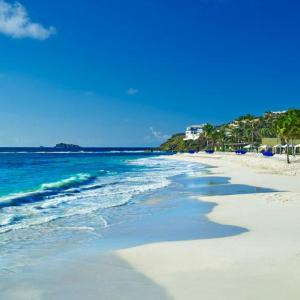
Named for the spectacular sunrises you’ll see from this part of the island, Dawn Beach is also protected by off-shore reefs and offers great opportunities for snorkeling. Swimming is also consistently good, and when the water picks up, surfers of wave, wind, and body take to the beach.

Fort Amsterdam is located near the capital of the Dutch part of the island: Philipsburg. The fort was built by the Dutch in 1631 on a peninsula that juts out between Great Bay and Little Bay. The Dutch fortification was attacked and conquered after a brief siege by the Spaniards in 1633.
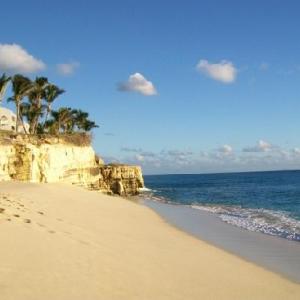
Located on the island’s southwest tip, Cupecoy is a set of three beaches surrounded by limestone cliffs. It’s also the last beach on the Dutch side before crossing the northern French border. Travelers say the sunsets here have to be seen to be believed, with dramatic views of Saba in the distance.

Restaurant le Soleil is properly named after the blanket of sunshine that overlays its large outdoor terrace for most of the day. Restaurant le Soleil’s outdoor dining room is one of the most beautiful places to eat. Reminiscent of the Greek islands, the room is set under a painted white wooden awning with deep blue accents. Enjoy the restaurant’s French-European cuisine while looking out over the sea and listening to the gentle waves lap up against the exterior.

Located on the Dutch side of the island, Maho Beach is unique in that patient visitors are able to get an up-close-and-personal view of the planes taking off and landing into the runways. Beware though, visitors should make sure to hold on tight to their belongings, the planes fly so close to the beach that items are often blown away!
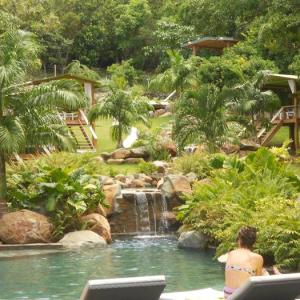
Comprising 135 acres of lush tropical land on the French side of the island, Loterie Farm is located at Pic Paradis, which is the highest point of the island. Visitors can partake in numerous activities amongst the beautiful grounds. You can go hiking or biking, while adventurous guests can try out their zip line course. Visitors looking for a more laid-back day can eat in the cafe, take a dip in the pool, or lounge in the gardens.
Accommodation:
Hotel room: $100
Food
BBQ meal: $15
Entertainment
Snorkeling gear rental: $15
Live Reggae band: free
Alcohol
Beer: $3
Accommodation
Hotel room/Apartment: $180
Food
2-Course evening meal: $40
Entertainment
Kitesurfing: $130
Car/ATV quad-bike rental: $35-65
Alcohol
Cocktail: $8
Accommodation
Hotel suite/Apartment: $300
Food
3-Course gourmet meal: $80
Entertainment
Motorboat rental: $300
Alcohol
Bottle of champagne: $100
When planning for your trip to Saint Martin/Sint Maarten, don’t forget about travel insurance! You never know what might happen and it’s better to be safe than sorry.

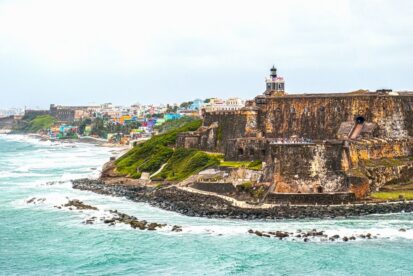


Interested in traveling the world while getting paid? Here at Diversifying Globetrotters LLC, we are partnered with Melanin On The Map and Travel Coach Network to help people across the world find financial, personal, and time freedom. Join the hundreds of others making the change to better themselves while exploring the world and adding money to their pockets.